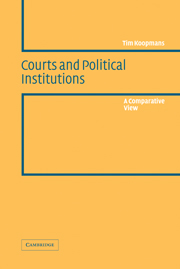Book contents
- Frontmatter
- Contents
- Preface
- Table of cases
- List of abbreviations
- 1 Introduction
- 2 The Sovereignty of Parliament
- 3 Judicial review of legislation
- 4 The growth of judicial power
- 5 The limits of judicial review
- 6 The legality of administrative action
- 7 Courts and governments
- 8 Courts and individual rights
- 9 Techniques of judicial protection
- 10 A glance at the future
- Select bibliography
- Index
7 - Courts and governments
Published online by Cambridge University Press: 26 February 2010
- Frontmatter
- Contents
- Preface
- Table of cases
- List of abbreviations
- 1 Introduction
- 2 The Sovereignty of Parliament
- 3 Judicial review of legislation
- 4 The growth of judicial power
- 5 The limits of judicial review
- 6 The legality of administrative action
- 7 Courts and governments
- 8 Courts and individual rights
- 9 Techniques of judicial protection
- 10 A glance at the future
- Select bibliography
- Index
Summary
Separation of powers
Separation of powers, in the American sense of the expression, hardly exists in countries with a parliamentary regime of government: although the judiciary is independent, the other two powers are intertwined. The government can only remain in power as long as a parliamentary majority is willing to support it; ministers are accountable to Parliament; and statutes are made – in fact, if not always in law – by the government and the Parliament acting together.
That is particularly true for Great Britain, where the development of cabinet government under a two-party system has tended to establish a clear distinction between the government and its parliamentary majority on the one hand, the opposition party on the other. This distinction characterizes the debates in the House of Commons, the directly elected house, where most decisions of political importance are discussed. The parliamentary debates illustrate that the executive is not independent, or ‘separate’ from the legislative bodies. Cabinet ministers participate in these debates as members of Parliament, from the government ‘front bench’. The opposition party has its own ‘front bench’, or ‘shadow cabinet’. Bills are usually introduced by government ministers; it is also possible for any MP to introduce a ‘private member's bill’, but such a bill will only be examined if it is compatible with the parliamentary timetable.
- Type
- Chapter
- Information
- Courts and Political InstitutionsA Comparative View, pp. 162 - 191Publisher: Cambridge University PressPrint publication year: 2003



